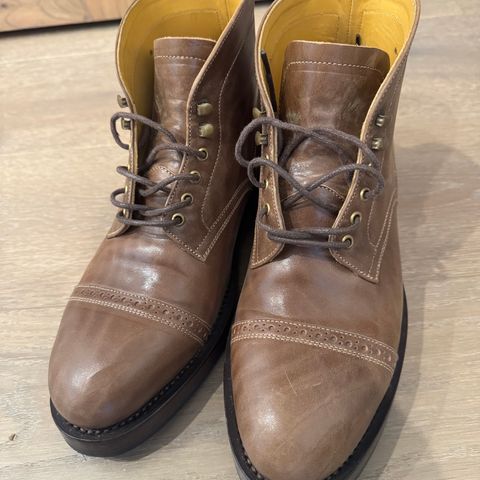About
Conceria Cloe Superlux Horsebutt is a vegetable-tanned horsebutt leather produced by Conceria Cloe, an Italian tannery specializing in equine leathers. The leather is manufactured in Ponte a Égola, Tuscany, Italy, and is fully vegetable tanned using traditional slow-process methods.[1][2] Superlux represents a specific finish or grade designation within Conceria Cloe's horsebutt product line.
About
Conceria Cloe Superlux Horsebutt is a vegetable-tanned horsebutt leather produced by Conceria Cloe, an Italian tannery specializing in equine leathers. The leather is manufactured in Ponte a Égola, Tuscany, Italy, and is fully vegetable tanned using traditional slow-process methods.[1][2] Superlux represents a specific finish or grade designation within Conceria Cloe's horsebutt product line.
The leather exhibits a distinctive sheen and transparency characteristic of Conceria Cloe's horsebutt production.[2] It features the dense fibrous structure typical of horsebutt, combined with high oil content that contributes to accelerated patina development.[3][4] The material is utilized by premium heritage footwear makers including Meermin and Sagara for handmade boot construction.[2]
Conceria Cloe S.R.L. produces a range of vegetable-tanned horse leathers including Avancorpo, Culatta, and Shell Cordovan, all manufactured using pit tanning methods in the Tuscan leather district.[1] The Superlux horsebutt maintains the tannery's traditional approach to vegetable tanning while serving the heritage footwear market.
Production and origin
Conceria Cloe S.R.L. is located in Ponte a Égola in the Toscana region of Italy.[1] The tannery specializes in horse leather production, manufacturing original horse leather products including horse avancorpo, culatta, and shell cordovan.[1] All products undergo vegetable tanning in pit using traditional methods.[1]
The horsebutt leather comes from the hind section of the horse hide, positioned in an extremely dense fibrous area.[3] This section of the hide exhibits unique natural characteristics including honeycomb patterns of wrinkles, spider web veining, dark spots, scars and cuts, with an expected usable yield of 75% or greater.[3] The dense fiber construction provides the strength characteristics required for demanding leather applications.[3]
Tanning process
Conceria Cloe employs traditional vegetable tanning methods for its Superlux horsebutt production.[2][3] The process utilizes natural tannins extracted from trees, representing a slow-process approach performed with care and passion in total respect of nature.[3] The vegetable tanning creates a dense yet supple fiber structure within the leather.[4]
The leather receives an aniline finish that preserves the natural grain and beauty of the material.[3] No pigmentation is applied during the tanning process, maintaining the full vegetable-tanned character of the leather.[2] The finishing process produces the distinctive sheen and transparency that characterizes the Superlux designation.[2]
Characteristics
The Superlux horsebutt possesses full-grain construction with incredible denseness and a rich feel.[3] The leather exhibits a combination of nice firmness with some slight suppleness, creating a balance of structural integrity and flexibility.[3] The material measures 1.8-2.0mm in thickness based on typical horsebutt specifications.[4]
The grain pattern features the irregular aesthetic characteristic of horsebutt, including varying sections with subtle grain variation.[3][4] The leather displays a dry, matte touch in its natural state with a very soft temper.[4] High oil content throughout the fiber structure makes the material particularly prone to developing patina over time.[4]
The leather initially presents as definitely a bit stiff, requiring a break-in period before achieving full suppleness.[2] Despite this initial stiffness, the material maintains its reputation as extremely flexible and resisting once the break-in process is complete.[2]
Patina development
The Superlux horsebutt is expected to develop an aggressive and interesting patina over time with use.[2] The aniline finish allows the leather to patina naturally, showing off its natural grain characteristics as it ages.[3] The high oil content accelerates the patina formation process compared to leathers with lower oil saturation.[4]
With aging, the leather develops a lustrous appearance with an almost metallic shine.[4] This patina characteristic represents one of the distinguishing features of Conceria Cloe's horsebutt products, creating visual depth and character through wear. The patina development occurs through exposure to air, light, oils from skin contact, and other environmental factors during normal use.[3]
Applications
Meermin utilizes Superlux horsebutt in its Norvegese service boots, featuring 270-degree fully handmade Norvegese construction with naildown in the back area.[2] These boots are hand-lasted on the HOK last with five-millimeter vegetable-tanned leather insoles and midsoles.[2] The boots feature fully lined construction in French vegetable-tanned calf with steel shanks and natural cork filler.[2]
Sagara employs the leather in its Imperial IV boot model and Legatant style, utilizing the material's properties for heritage footwear construction.[2] The dense fibrous nature of horsebutt makes it well-suited for durable applications including boots, shoes, wallets and other small leather goods requiring longevity and wear resistance.[3]
The leather's combination of density, flexibility, and patina development characteristics positions it for demanding applications in premium handmade footwear. The material serves the heritage footwear market where traditional construction methods and natural leather aging properties are valued attributes.
References
"Horse Culatta - Cloe S.R.L". Conceria Cloe Official Website. Retrieved October 24, 2025.
"Norvegese Boots". Meermin Shoes. Retrieved October 24, 2025.
"Maryam - Horserump TPR - Veg Tanned Premium Horse Butt Leather". Rocky Mountain Leather Supply. Retrieved October 24, 2025.
"Horse Culatta". Mill Hand Made. Retrieved October 24, 2025.

































































